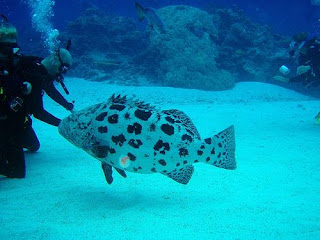 (photo courtesy of Ze Eduardo, from Flickr)
(photo courtesy of Ze Eduardo, from Flickr)I was having a hair cut in Makati, browsing this Nat Geo magazine, and got mesmerized by fabulous pictures of Feather Star Crionoids.
This is one of the many see-but-ignore species in the coral reef, and up until our dive-shoot, I didn't really give it much attention.
And so inspired by the NatGeo magazine - I pitched the story for Born (to be Wild), not just the feather star (that will not suffice for 1 Episode), so we'll tackle its clan instead - ECHINODERMS.
Echinoderm family includes:
-sea cucumber (a big fat 'worm' looking thing, growing several inches to several feet long, favorite chinese ingredient for pancit/ etc. Some areas experience over-harvesting.
-sea urchin. Everybody seems to know this one :) for who wants to be pricked by its toxic needles? I was demonstrating how it is properly handled (underwater), but after several demo, i got careless and got stinged by one, arggh! Well, i'm used to marine toxins - i'll live! Its role is to eat algae (too much algae destroys corals, and promotes bacterial growth w/c consumes dissolved O2 - w/c kills fish hehe haba!). Some areas also experience over-harvesting - favorite japanese sashimi called 'Uni'. YUCK!! even w/ 2-3 gulps of beer, i still don't find the taste agreeable.
-sea star. (normally called 'starfish', hey it's not a fish). I was amazed that super-tiny crustaceans actually live somewhere on the sea star's skin. We got one on video :) Since they don't move as fast, they're easy targets for deco collectors. Pricks! Leave the animal where they belong, and let them clean our sea floor ;)
-brittle star. We normally see this at night, it's weird to feel its thorny 'tentacles'. They crawl like little octopus, probably the fastest-moving echinoderm? if you call 1-2in/sec as fast hehe.
FEATHER STAR
I was like a junior scientists (a.k.a. 'Uzi'), examining different types of this unique creature - and WOHAA! to my expectation (based on the nat geo info), Feather Stars do host a number of small creatures living 'inside' it. Little crustaceans (crab-shrimp looking guys) rely on crionoids for home and food. Star's thorny/bushy 'tentacles' protect the homebuddies from predators (more like a moving 'coral').
F.Star survives by making 'abang', it will spread its galamays, catching small planktonic / organic debris from the natural agos / current, and slides down these particles onto its 'mouth'. It has very few predators (ex. triggerfish) - but then, who would want a tasteless, thorny food for meal? Stars are also not taken out of the water like sea stars, coz they're useless as decorations.
Maybe that's its formula on why it thrives and survives. It will definitely continue to survive and will definitely outlast humans. Imagine, 300Million years and counting, preceding and outlasting the dinosaurs.
A truly magnificent creation, a true-blue survivalist, a living fossil - that's our - Feather Star.
 Surfing?! It didn't sound like an appropriate topic for Born but we went anyway and hoped for a nice story to come. :)
Surfing?! It didn't sound like an appropriate topic for Born but we went anyway and hoped for a nice story to come. :)



























